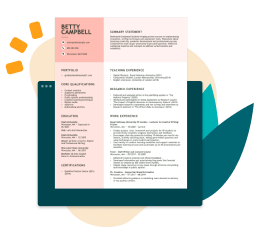CV vs. Cover Letter: Differences, Benefits & Examples
CVs and cover letters are used to apply for jobs, posts and academic positions. However, they are entirely different documents. We’ll explain those differences and give tips to nail each!
What Is the Difference Between CVs and Cover Letters?
A cover letter is a brief, personalized letter to potential employers explaining why you want the job. In contrast, a CV is a more detailed document (typically two to eight pages) highlighting your professional experience and educational background. While the CV showcases your qualifications, the cover letter focuses on your motivation and fit for the role.
Check out this chart, which compares CVs and cover letters side-by-side and provides examples to help you better understand the differences.
CV vs. cover letter
Next, we’ll get into the fine details about what you need to include in each document to impress employers.
However, if you’re ready to launch into creating your documents, check out our best tool for the job, our CV Maker.
It can help you make resumes and CVs, plus it comes with access to our Cover Letter Generator. Since the builder is fully automated, it can help you complete your documents in 15 minutes!
What Is a CV vs. a Cover Letter? What to Include in Each
CVs and cover letters work in tandem to make a convincing case for why you deserve a job. Next, we’ll look into more detail about what each document consists of and what each should achieve to be successful, starting with the CV.
What is a CV?
A CV (short for curriculum vitae) is a detailed document that outlines your skills, educational background and work experience. It’s similar to a resume but longer and contains more sections and a greater focus on your academic history.
In many countries, a CV and resume mean the same thing. However, in the U.S., CVs are primarily used for academic, research and scientific positions and have more sections.
Like a resume, what you include in a CV consists of the five primary sections:
CVs often include additional sections:
- Awards and Honors
- Languages
- Research Projects
- Publications
- Conferences
- Grants
- Teaching Experience.
You can see how other candidates customize their CVs by checking out some CV examples.
Similarly, if you need help finding a design you like, we have a collection of CV templates. Professional designers created these templates so you can skip formatting and jump straight to plugging in your information.
What is a cover letter?
A cover letter is a professional business letter that highlights your key qualifications and achievements, showing why you’re the ideal candidate for the role. Unlike a CV or resume, a well-written cover letter showcases your personality and tells a compelling story about your career accomplishments, motivations and what makes you an excellent fit for the position.
The general cover letter format follows this organization:
- Header featuring your contact information
- The recipient’s address
- A salutation and greeting
- An introduction paragraph
- Two to three main body paragraphs
- A closing paragraph
- Professional sign-off phrase
- Your name or signature
When you break down each part of these two job application documents, it’s clear that a cover letter and CV are very different. However, how they fit together can powerfully impact your job chances!
CV vs cover letter: similarities + how they complement each other
CVs and cover letters work together to showcase your qualifications and impress potential employers.
Think of the CV as a map outlining your professional journey, listing skills, experiences and achievements. The cover letter serves as a compass that guides the reader with a personalized narrative that explains your motivation and highlights key accomplishments.
To make an impactful impression on recruiters, ensure your cover letter complements your CV by expanding on one notable achievement you mentioned in your CV.
In addition to the content, having a consistent design across both documents demonstrates attention to detail and professionalism.
Key Takeaways
- CVs and cover letters are documents used to apply for jobs and opportunities.
- Understanding the distinction between a CV and a cover letter is vital for optimizing your application.
- A CV outlines your skills and experiences comprehensively, while a cover letter shares your motivations and personality.
- CVs typically include more sections than a resume or cover letter.
- In contrast, cover letters follow a standard business letter format, highlighting key points from your history.
- Just as a map and compass work together, a CV provides the roadmap, while a cover letter offers direction.
- Ensure both documents complement each other and have matching designs to convey professionalism.
Featured in:*

*The names and logos of the companies referred to in this page are all trademarks of their respective holders. Unless specifically stated otherwise, such references are not intended to imply any affiliation or association with LiveCareer.





